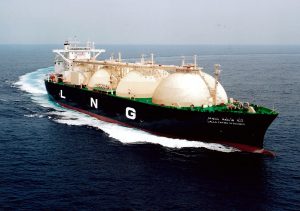For a long time natural gas has exclusively been a grid-bound energy carrier. In consequence, markets for natural were not globalized, but there were several submarkets (see Tutorial 1) which supplied themselves. Furthermore, the price level in the various markets varied as no arbitrage between the markets was possible.

In the past ten years the submarkets started to integrate due to the increasing use of liquefied natural gas (LNG). In order to transport natural gas in a liquefied form a transport chain of three elements is required:
- A liquefaction plant to liquefy the natural gas and storage facilities located with sea access in the exporting country. The natural gas is cooled down to low temperatures (about -160 °C) and by this liquefied. For this purpose a high energy input is required. The plant has to be supplied with natural gas (e.g. via pipelines). Deposits located near to the coast have an economic advantage over deposits which are located in the inner country. Storages are required to ensure a location’s flexibility between incoming and outgoing natural gas. While the gas arrives continuously via pipeline, the purchase only takes place when a tanker is in the port.
- LNG tankers. As the liquefied gas has to be held at a certain temperature in order to prevent the gas from becoming gaseous again and build up pressure in the tank, the LNG tanks on the tankers have to be extremely well isolated. For this reason the ships are usually equipped with ball tanks. The ball shape has the best volume-to-surface ratio and, therefore, the best properties to ensure a good isolation. When filling the tanks in the port, the tank must first be filled with an inert gas (CO2 or nitrogen) in order to prevent natural gas, which is gradually filled in, from forming an explosive mixture with the oxygen of the air. When using LNG tankers, significant scale effects exist as with other tankers. Larger ships are cheaper per unit load than smaller ships
- A regasification plant in the importing country in which the liquefied gas becomes gaseous again so it can be fed back into the pipeline system. Natural gas tanks are usually required again in order to ensure the necessary operational flexibility.
The more LNG exporters and the more LNG importers share the market, the higher becomes the flexibility of the suppliers and of demand as well. If, for example, the European natural gas price is low, the LNG exporter can supply natural gas to Japan, where possibly higher prices can be achieved. The increasing use of LNG makes arbitrage trading possible and led to similar prices for natural gas in in different regions of the world. A little less than 20 percent of the European natural gas demand is covered by LNG imports.
Due to the relatively low energy density of LNG the transport via pipeline is expensive as soon as it comes to a long distance. This applies not only to the investment cost but also to the operating costs. The transport per ton of oil equivalent (per unit of energy) is a lot more expensive than the transport of oil or coal as it can be seen in figure 1.

Figure 1: Comparison of costs for energy transport via long distances (source: BGR Energierohstoffe 2009)
Whether the transport via LNG or via pipeline is cheaper depends on the distance between producer and consumer. In general transportation via LNG is cheaper from a distance of 2,000 to 4,000 kilometers. Still, Russian natural gas is transported via pipelines over a distance of up to 5,000 kilometers to Germany. Due to the fact that there is no access to an ice-free sea near the Siberian natural gas fields, it cannot be transported via LNG.



